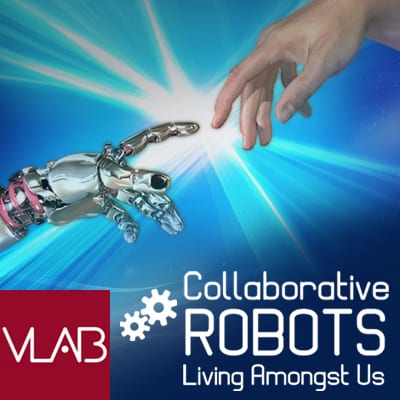The VLAB Collaborative Robots forum on Thursday May 29 was a masterclass for robot startups. For 90 minutes at the Knight Management Center at Stanford, we heard all about the business of robotics from industry veterans, vcs and startups. The panel consisted of Melonee Wise, CEO of Unbounded Robotics, Milan Shah, VP of Rethink Robotics, John Dulcinos, VP of Automation at Jabil and Peter Hebert, cofounder of Lux Capital. The panel was moderated by myself, Andra Keay, Managing Director of Silicon Valley Robotics.
The MIT Enterprise Forum Bay Area (VLAB) was formed in 1990 and is one of 30 chapters around the world. VLAB helps startups and entrepreneurs find the best practices for developing viable business models for technology-oriented markets. The VLAB events are sponsored by the Stanford University Office of Technology Licensing, and the Alumni Association of Stanford’s Graduate School of Business. The caliber of presenting companies and panelists at our events has earned VLAB the reputation as one of the premier high-tech forums in Silicon Valley.
The VLAB committee conducted quite a rigorous audition process for panelists (and moderators) looking for the most successful examples of companies in the industrial/service collaborative robotics space. VLAB panels usually consist of two startups, an incumbent company whose business model is under threat from the startups, and an investor. This was a really successful balance of opinions, although it’s humbling to realize that a company like Rethink Robotics is still considered a startup.
The panel opens with a 10 minute overview of the economics of robotics and then an indepth look at Unbounded Robotics. Then the panel discussion really gets going with both John Dulchinos and Peter Hebert schooling us in the opportunities and challenges for robotics startups. I came away with a much better appreciation of the huge potential for industrial and logistical robotics. Not all successful robotics businesses are venture fundable, and understanding the customer/market space is still the biggest challenge for startups.
We are now standing at the dawn of a new robotic era. Robots are learning to perform complex tasks and to interact with humans in boundless environments. Naturally, Silicon Valley entrepreneurs are at the center of this disruption.Massive new markets are opening up. A new generation of innovative robotic platforms is emerging with human cadence and more adaptable automation solutions. According to TechNavio, the global service robotics market is expected to grow at CARG (compound annual rate growth) of 20%. Industrial robots will reach $37 billion by 2018. The agricultural robots market is also expected to reach $16.3 billion by 2020, 20 times its current value.Will these robots facilitate the predicted re-shoring or renaissance in US manufacturing? And what will be the economic consequences of this new co-habitation?


